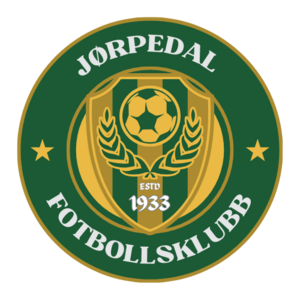Jørpedal FK
Jørpedal Fotbollsklubb, known as Jørpedal FK, or simply Jørpedal, for short, was a professional Olmerian football club based in Neuvesto for 63 years from 1933 - 1996. The team were based at the Olejern Arena for all of their existence, named after the park they played in prior to becoming professional, which was in turn named after local legend Sven Olejern.
The club won the top division of the OLF, the Første Liga, 7 times between 1935 and 1984, making them the joint 5th most successful club in the leagues history.
From 1990 onwards, growing financial difficulties meant the team were relegated 4 times in just 5 seasons as they sold most of their players in an attempt to survive bankruptcy. Eventually, in January 1996, now playing in the Liga Nul, the club were declared bankrupt by the Olmerian sports regulators FOSR (Financial and Operational Sports Regulation), and forced to dissolve after supporters failed to raise the finances needed to buy out the club.
History
Foundation and Early Development (1897-1901)
Jørpedal was founded as an amateur club at the end of the 19th century, under the official title Jørpedal Amateur FK. The club was named eponymously with it's home borough in the southern suburbs of Neuvesto, an area where football had rich cultural roots, having been played on the streets in casual capacities for several centuries. The decision to form an official amateur club came amidst a growth in local amateur competitions which required official registration, in contrast to the entirely informal games organised previously by the unofficial local team under the same name. Funding from local businessman Martin Breivik, who was to run the club, allowed the team to buy the goalposts and other equipment necessary to register as an official team.
In their first three years as a registered team the club continued in much the same vein, playing in the occasional local cup competitions, in addition to continued series of friendlies with neighbouring teams. These friendlies attracted little local attention, and with the teams best cup performance being a single victory to take them to the second round, there was little for the locals to get excited about.
The team spent these early years playing home games at the local recreational park, in a large field with no designated stands or facilities. In 1900, locals contributed to renovating the back rooms of the parks pavilion to form makeshift changing rooms leading out on to the pitch, making the set-up more appealing to visiting teams and allowing for development into a proper amateur club. In fact despite the continued lack of facilities for fans, from 1900 onwards home games drew substantial crowds from local residents, sometimes reaching over 400 people gathered standing around the park. Soon several small food stands could be seen popping up at every game to make the most of the business opportunity.
As a result of this attendance, Jørpedal players quickly became local celebrities and places on the team were highly sought after. The clubs had initially been managed and run simultaneously by local small-shot businessman Martin Breivik, but with the scope of competition and support expanding there became a need to expand the management team to match. In 1901 he appointed Harvey Øystein as the teams head coach, in addition to a small team of volunteer coaches and one physio
Amateur Competition (1900-1933)
In the fragmented footballing environment of the late 19th and early 20th centuries, there were no unified national competitions, and amateur and professional (of which there were still very few) teams alike competed in smaller regional competitions. As such, Jørpedal's seasons from 1900 until 1933 consisted of participation in such competitions, although often with extreme unpredictability due to weather events, organisational challenges and travel issues.
